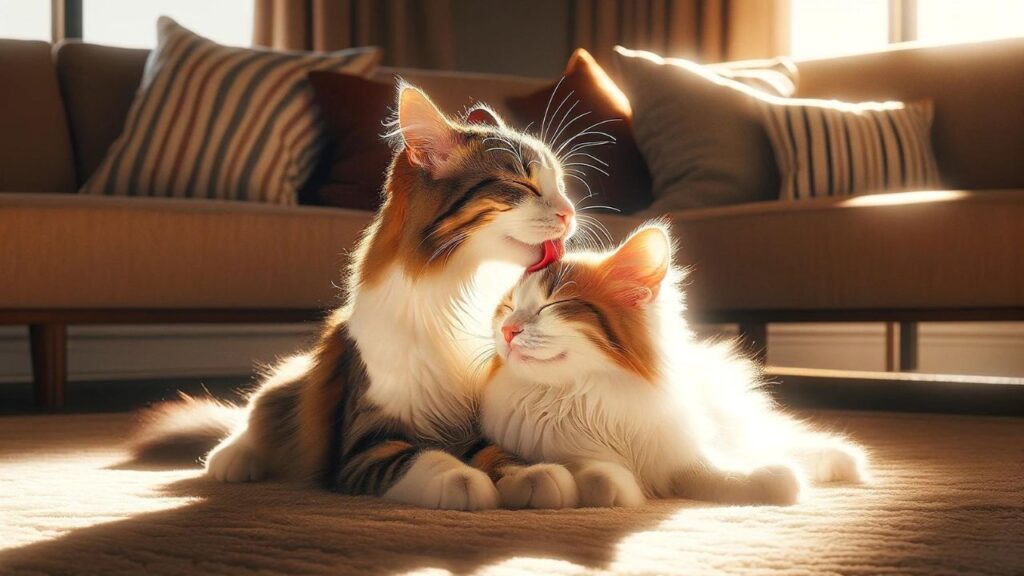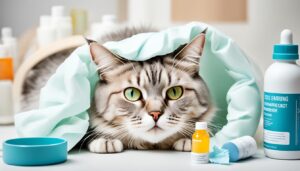Cat Grooming: Have you ever caught your cat in the middle of a grooming session and wondered why they do it? It’s not just about staying clean. Grooming is a cat’s way of showing love, staying healthy, and building friendships. But why do they sometimes groom us, too?
In “Feline Affection: The Mystery of Cat Grooming,” we’re diving into the real reasons behind those meticulous grooming habits. From the silent ways cats communicate affection to the surprising health perks grooming offers, there’s a lot more going on than meets the eye.
Curious about why your furry friend spends so much time grooming or what it means when they try to groom you? Stick around. We’re about to explore the loving world hidden within every lick and purr.
Understanding Cat Grooming

Basics of Cat Grooming
Imagine a cat’s tongue as a super-efficient, built-in comb that not only cleans their fur but also helps them cool off. This self-grooming isn’t just about vanity; it’s a survival instinct. Cats start learning this essential skill from their mothers when they’re just a few weeks old.
Why Cats Groom Themselves
Beyond the obvious cleanliness, grooming helps cats deal with the heat and stress. The act of grooming releases endorphins, which are feel-good hormones, making it a comforting behavior that can soothe anxiety.
The Social Side of Cat Grooming
Allogrooming: Cats Grooming Each Other
This mutual grooming is a way for cats to take care of each other, reaching places hard to clean by themselves. It’s also a peace-making or friendship gesture, often observed in cats that live together and get along well.

Decoding Cat Grooming Behaviors
Grooming can signal social status within a group of cats. The one being groomed by others is typically more dominant. So, when your cat grooms you, it’s not just affection; they might also be saying, “You’re important to me.”
Health Benefits of Cat Grooming
Fighting Off Fleas
By grooming, cats effectively remove fleas, dirt, and debris from their fur. The saliva contains enzymes that can kill bacteria, making grooming a crucial part of their health routine.
Grooming for a Healthy Mind
Regular grooming is akin to a self-care ritual for cats, helping them to reduce stress levels and feel secure. It’s a way for them to recover from a stressful event or adapt to changes in their environment.
Grooming as Cat Talk
Grooming Shows Affection
When cats groom you, it’s their way of weaving you into their world, treating you as part of their family or clan. This grooming can feel a bit rough due to the texture of their tongues but take it as a compliment.
Choosing Their Grooming Buddies
Cats are picky with their grooming partners, selecting individuals they trust and feel comfortable with. This choice is a big deal in the feline world, reflecting deep emotional bonds.
Bonding Over-Grooming
Stronger Bonds Between Cats
For cats, grooming is like having a trusted friend they can relax and be vulnerable with. It’s a significant indicator of trust and affection, reinforcing their social bonds.
Cats and Humans: Grooming Bonds
When cats attempt to groom their human friends, it’s a sign of ultimate trust and comfort. They see you as a part of their social group, a gesture that should be received with gratitude and affection.
Understanding and Reacting to Grooming
What It Means When Cats Groom Humans
It’s a mix of affection, social bonding, and perhaps even a bit of caregiving on their part. They might also enjoy the taste of the salts from your skin, which is a bonus for them.
How to Respond
Let them proceed but watch for signs of over-grooming, which can indicate stress. Gently distract them if needed, but always acknowledge this act of love with gentle pets or kind words.
Supporting Your Cat’s Grooming Needs
Picking the Right Tools
Not all cats have the same grooming needs. Short-haired cats might just need occasional brushing, while long-haired breeds can benefit from daily grooming sessions to prevent mats and tangles.
Knowing When to Call in the Pros
Professional groomers can be a great help, especially for cats that don’t tolerate much handling or have developed mats that are too tough to untangle at home.
Conclusion
Grooming is more than just a cleanliness habit for cats; it’s a language of love, a sign of social bonds, and a crucial part of their mental and physical health. By understanding and participating in your cat’s grooming routine, you’re not just helping them stay clean; you’re also strengthening your bond and ensuring they feel loved and secure.
FAQs
Why do cats groom themselves so frequently?
Cats groom themselves to regulate body temperature, remove dirt and parasites, distribute natural oils, and show self-care.
Is excessive grooming a cause for concern in cats?
Excessive grooming can indicate stress, skin issues, or underlying health problems, warranting a vet visit.
Do cats groom each other as a form of bonding?
Mutual grooming among cats strengthens social bonds within a group and promotes harmony.
How can I help my cat with grooming if they are elderly or have mobility issues?
Providing regular brushing sessions and grooming assistance can help elderly or less mobile cats maintain their coat health.
What grooming tools are best for my cat’s coat type?
Slicker brushes, combs, and grooming gloves are ideal for different coat lengths and textures in cats.
Should I bathe my cat to help with grooming?
Cats are generally self-cleaning, but occasional baths may be necessary for long-haired breeds or if they get into something messy.
Why do some cats dislike being groomed?
Sensitivity to touch, past negative experiences, or pain can make some cats averse to grooming sessions.
Can over-grooming lead to skin problems in cats?
Excessive grooming can cause skin irritation, hair loss, and even create hot spots on a cat’s skin.
How often should I groom my short-haired cat?
Short-haired cats benefit from regular brushing sessions at least once a week to remove loose fur and prevent matting.
What are the benefits of using cat-specific grooming products?
Cat-specific grooming products are formulated to suit feline skin pH levels and coat requirements, promoting healthy grooming habits.
Do indoor cats require less grooming than outdoor cats?
Indoor cats may require more frequent grooming due to dust accumulation and lack of natural abrasive surfaces like trees for scratching.
Can diet affect a cat’s grooming habits?
A balanced diet rich in essential nutrients supports healthy skin and coat, positively impacting a cat’s grooming routine.
How can I introduce my cat to grooming if they are not used to it?
Gradual introduction, positive reinforcement with treats, and short grooming sessions can help acclimate cats to the grooming process.
Are there specific areas on a cat’s body that require special attention during grooming?
Areas like the belly, armpits, and hindquarters may need extra care during grooming to prevent matting and skin issues.
Should I trim my cat’s nails as part of their grooming routine?
Regular nail trims are essential for maintaining your cat’s claw health and preventing accidental scratches or snagging.
Can professional groomers assist with cat grooming needs?
Professional groomers experienced in handling feline clients can provide specialized services like dematting or lion cuts for long-haired breeds.
How does regular grooming contribute to a cat’s overall well-being?
Regular grooming helps prevent hairballs, reduces shedding, promotes circulation, and strengthens the bond between a cat and their owner.
What signs should I look for that indicate my cat needs professional veterinary attention related to grooming issues?
Signs like persistent itching, bald patches, skin lesions, or changes in grooming behavior warrant a vet visit for proper diagnosis and treatment.
Can stress or anxiety affect a cat’s grooming habits?
Stressors like changes in environment or routine can lead to over-grooming or under-grooming in cats as a coping mechanism.
How can I create a calming environment for my cat during grooming sessions?
Using soft voices, gentle handling, providing treats, and incorporating familiar scents can help create a soothing atmosphere for your cat during grooming sessions.
References
| International Cat Association (TICA) | https://www.tica.org/ |
| The Cat Fanciers’ Association (CFA) | https://cfa.org/ |
| World Cat Federation (WCF) | https://www.wcf-online.de/ |
| Fédération Internationale Féline (FIFe) | https://www.fifeweb.org/ |




[…] for many individuals, and they are primarily caused by certain proteins that cats produce. When cats groom themselves, these proteins are secreted onto their fur and through their saliva, making them […]
[…] back to Ernest Hemingway’s time. These cats are named after the famous writer who had a deep affection for polydactyl felines. It is said that Hemingway was gifted Snowball, a six-toed cat, and from […]